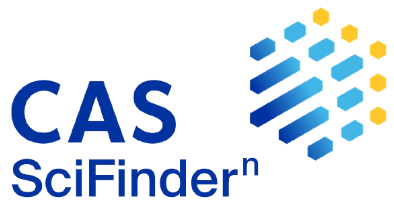Synthesis of substituted 2-hydrazinoquinazolin-4-ones as intermediates for heterocyclic compounds synthesis
DOI:
https://doi.org/10.24959/ophcj.14.810Keywords:
2-hydrazinoquinazolin-4-one, 2-thioxoquinazolin-4-one, hydrazine, nucleophilic substitutionAbstract
A suitable and effective scheme for the synthesis of 2-hydrazinoquinazolin-4-ones has been suggested and tested. It can provide a wide chemical diversity of the final products. The scheme developed starts from esters of 2-isothiocyanobenzoic acids, which easily form 3-substituted 2-thioxoquinazolin-4-ones with a high yield in the reaction with primary amines. When refluxing the latter in a heterogenic emulsion of dioxane and hydrazine hydrate the nucleophilic substitution of the sulfur atom occurs with 3-substituted 2-hydrazinoquinazolin-4-ones formation accumulated in the dioxane phase. After separation of the dioxane layer and dilution with water the precipitate of sufficiently pure target 2-hydrazinoquinazolin-4-ones is formed. Under these conductions there is no splitting of the amide group, which can be a part of substituents. But in case of amides of (4-oxo-2-thioxo-1,4-dihydroquinazolin-3(2H)-yl)acetic acid after inserting of the hydrazine substituent the cyclization occurs as a result of the intramolecular substitution of the amine residue of the amide fragment with formation of 2H-[1,2,4] triazino[3,4-b]quinazoline-3,6(1H,4H)-dione. The structure of the compounds synthesized has been proven by elemental analysis and 1H NMR spectroscopy data. The compounds obtained are promising synthones for construction of diversified heterocyclic systems, which can be of interest as potential pharmacological substances.
Downloads
References
- Savitsky P. V., Vas’kevich R. I., Staninets V. I., Vovk M. V. Zhurnal organichnoi ta farmatsevtichnoi khimii – Journal of organic and pharmaceutical chemistry, 2013, Vol. 11, No.2(42), pp.3-19.
- Voskoboynik O. Yu., Kovalenko S. I., Karpenko O. V., Skorina D. Yu., Berest G. G., Nosulenko I. S., Krivoshey O. V. Zhurnal organichnoi ta farmatsevtichnoi khimii – Journal of organic and pharmaceutical chemistry, 2012, Vol. 10, No.1(37), pp.3-18.
- Ibrahim Y. A., Elwahy A. H. M. Heteroatom Chemistry, 1994, Vol. 5, No.2, pp.97-101.
- Alvarez-Builla J., Vaquero J. J., Barluenga J. Modern heterocyclic chemistry. Weinheim: Wiley-VCH, 2011, Vol. 1, pp.659.
- Ghorab M. M., Ragab F. A., Heiba H. I., Bayomi A. A. Arzneimittelforschung, 2011, Vol. 61, No.12, pp.719-726.
- Shawali A. S., Hassaneen H. M., Shurrab N. K. Heterocycles, 2008, Vol. 75, No.6, pp.1479-1488.
- Alagarsamy V., Parthiban P., Solomon V. R., Dhanabal K., Murugesan S., Saravanan G., Anjana G. V. Journal of Heterocyclic Chemistry, 2008, Vol. 45, No.3, pp.709-715.
- Alagarsamy V., Sharma H. K., Parthiban P., Singh J. C. H., Murugesan S., Solomon V. R. Pharmazie, 2009, Vol. 64, No.1, pp.5-9.
- Alagarsamy V., Rupeshkumar M., Kavitha K., Meena S., Shankar D., Siddiqui A. A., Rajesh R. European Journal of Medicinal Chemistry, 2008, Vol. 43, No.11, pp.2331-2337.
- Ram V. J., Srimal R. C., Kushwaha D. S., Mishra L. Journal of Protein Chemistry, 1990, Vol. 332, No.5, pp.629-639.
- Liu K. C., Hu M. K. Archiv der Pharmazie, 1986, Vol. 319, No.2, pp.188-189.
- Liu K. C., Hu M. K. Archiv der Pharmazie, 1987, Vol. 320, No.8, pp.765-766.
- Saleh M. A., Abdel-Megeed M. F. Journal of Carbohydrate Chemistry, 2003, Vol. 22, No.2, pp.79-94.
- Deshmukh M. B., Patil Suresh S., Patil Sanjeevani S., Jadhav S. D. Journal of Heterocyclic Chemistry, 2010, Vol. 47, No.5, pp.1144-1147.
- Murdoch R., Tully W. R., Westwood R. Journal of Heterocyclic Chemistry, 1986, Vol. 23, No.3, pp.833-841.
- Ivachtchenko A. V., Kovalenko S. M., Drushlyak O. G. Journal of Combinatorial Chemistry, 2003, Vol. 5, No.6, pp.775-788.
Downloads
Published
How to Cite
Issue
Section
License
Copyright (c) 2014 National University of Pharmacy

This work is licensed under a Creative Commons Attribution 4.0 International License.
Authors publishing their works in the Journal of Organic and Pharmaceutical Chemistry agree with the following terms:
1. Authors retain copyright and grant the journal the right of the first publication of the work under Creative Commons Attribution License allowing everyone to distribute and re-use the published material if proper citation of the original publication is given.
2. Authors are able to enter into separate, additional contractual arrangements for the non-exclusive distribution of the journal’s published version of the work (e.g., post it to an institutional repository or publish it in a book) providing proper citation of the original publication.
3. Authors are permitted and encouraged to post their work online (e.g. in institutional repositories or on authors’ personal websites) prior to and during the submission process, as it can lead to productive exchanges, as well as earlier and greater citation of published work (see The Effect of Open Access).














